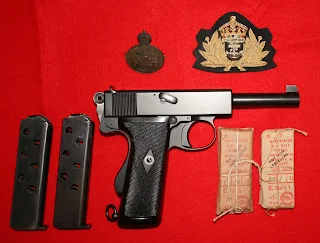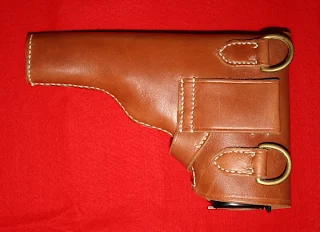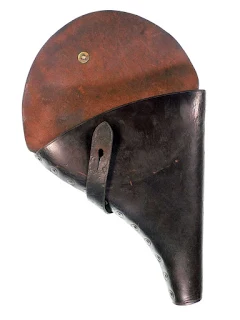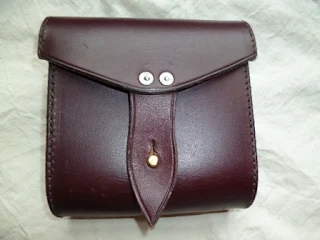Originally a pejorative term
referring to the alleged gullibility of the British Royal Marines serving
aboard ships of the Royal Navy where they were not as familiar with the ways
of the sea as the Matelots, i.e., sailors, and would believe most anything. However, at
some point in time the term’s meaning was reversed by the U.S. Marine Corps, in that the marines (both British and American) had
served in many places, observed many nations and cultures, experienced many
things, and acquired a great deal of practical knowledge. Therefore, if a dubious
issue arose and was questioned, and a Marine said it was true, it must be true.
So this is intended as a segway
into a recent very rare item, which after at least three decades, I found in
what was to me a very unlikely location. In 1982 at the then well-known Great
Western Gun Show at the massive Los Angeles County Fair Grounds in Pomona,
California, I was able to acquire a near mint Webley-Scott Model 1912 Semi-Automatic Pistol Mk I in .455cal. British nomenclature is “Self-Loading”. The
gun was the “commercial” model, which subsequent research showed was one of a
lot of 136 private sales pistols manufactured in the month of December of 1914.
It was identical in every respect, except slightly different markings, to the
pistols then being produced under government contract. During the entire span
of production there were only 1248 “non-government contract” models ever manufactured. A majority of these pistols were thought to have been purchased by officers of the British Armed Forces, as was their prerogative at the time, and carried during World War I. Records establish that the Army & Navy Cooperative Society Ltd sold over 200 weapons between January 1913 and January 1915, for the most part to British army officers. In the case of this specific gun its serial number in the 118... range, establishes a date of manufacture in December 1914. If it belonged to an officer, the person must have had a staff billet well behind the lines, given its condition. For readers who may not recognize it, the bronze badge shown beside a Royal Navy officer's cap badge, is the collar device or "dog" (often misidentified as a cap badge) of the Royal Navy Air Service Armoured Car Squadron during World War I.
Because of the virtually new
condition of the weapon and its rarity, I have never fired it, and have subsequently searched
for both original ammunition and accessories. The holster shown is obviously a modern reproduction of one of the various styles originally manufactured and issued for the pistol. One specific item has eluded me
for decades, that being a spare magazine in reasonably good condition. I have
searched gun shows, and more recently the internet, without success, until very
recently.
Approximately a month ago,
in a normal monitoring of various web sites, came upon a dealer offering the
precise magazine in excellent condition. He was smart enough to provide extensive
colored photography of the magazine, such that it was possible to insure it was
absolutely righteous, by comparing it to the magazine original to my pistol.
The additional unique aspect of all of this was that he was located in Warsaw,
Poland. “Tell it to the Marines!”
Now with the magazine safely delivered, the
dealer indicated that he had purchased the magazine from a person in Germany,
but was certain that it had previously come from France. Logical, given the presence of the Royal Naval Division, Royal Marines, Royal Flying Corps, Royal Horse Artillery, and the British Army Expeditionary Force, in France during World War I. All being issued (as a limited standard), and/or using this model Webley in various Marks and Mods. It has now come a long
circuitous route from its original place of manufacture, Birmingham, England. “Tell it to the Marines!”.
It would appear that the Royal
Navy showed considerable foresight in adopting the Case, pistol almost a
year in advance of the Pistol, self-loading, Webley and Scott, .455-inch,
Mark I, which was not formally approved until 19th May 1913, as announced by
LoC. §16403. The reality is that the decision to adopt the Webley Scott pistol
had already been taken by early 1912. As with the pattern 1901 Accoutrements,
there appears to be no LoC. entry or other documentation that has come to
light, identifying when it was declared obsolete.
Shown below are a series of photographs of a Royal Navy original issued holster, manufactured in 1912 for use with the pistol, and a variant. Rather than stitching, rivets predominate in the construction of the holster, as they were believed to hold up better in the marine environment, although only a small percentage of the weapons were thought to have gone to sea. The original issued magazine/ammunition pouch is also shown below. Am currently in the process of taking delivery of museum quality replicas of each from Kevin and Jenny Beckhurst, who operate the Military History Workshop in Cornwall, England. Note: Having subsequently received both, can personally attest to the superior quality of their craftsmanship.
Along the way, have acquired Pattern 1925 Carrier, Magazine, Pistol, which was introduced with the Web Equipment, R.A.F. Pattern 1925. See; Air Ministry Weekly Order No. 793/1927, as Stores Ref. 23/79. It was designed to carry two magazines for the .455-inch Colt Semi-Automatic Pistol. The first example below is from someone else's collection. I made the grievous error of trying to clean mine up, and it has both shrunk and faded, as you will see in the photographs. As you also can see, it may as an alternative, have held a pair of Webley magazines in its original condition. The magazines shown in the second pouch below are for; on the left, .45cal. Colt M1911A1, and on the right, the .455cal. Webley Model 1912 Mk I.
Research however indicates that the only purpose built, ordnance specified, magazine carrier for the Webley Semi-Automatic Pistol was manufactured of leather, and was designed to carry 2 extra magazines, plus an additional seven 7 cartridge packets of ammunition. This would provide an additional 63 rounds. Shown below is an original issue leather holster and ammunition pouch for the pistol, an original magazine/ammunition pouch, and a modern museum quality reproduction crafted by Military History Workshop.
The Pouch,
cartridge, pistol, Mark I. Brown leather was approved on 31st May 1912
and announced as part of the Accoutrements, Naval, Pattern 1912 by List of Changes paragraph §16043 of 1st August
1912. It was designed to carry 49 rounds in 7 packets plus 2 spare magazines
(charged, 7 rounds each) giving a total of 63 rounds. The magazines were held
below the top opening of the Pouch
by four spring clips. The position of the magazines was intended to minimize
the loss of ammunition from the Pouch.
The Pouch, cartridge, pistol
measures 5 ½-inches wide by 5 ½-inches high by 2 ¼-inches deep.
The Sub Lt. below shows the standard Webley Auto kit first seen just prior to the outbreak of WW1. With full acknowledgement and expressed gratitude to; NAVYWEB MkII a Division of the Historical Maritime Society (U.K.)
For the reader who might be interested in additional information on the .455cal. Webley Model 1912 Semi-Automatic Pistol Mk I, please see; http://arnhemjim.blogspot.com/2011/10/other-webley-limited-standard-semi.html and http://arnhemjim.blogspot.com/2013/02/the-other-webley-addendum.html .









































No comments:
Post a Comment